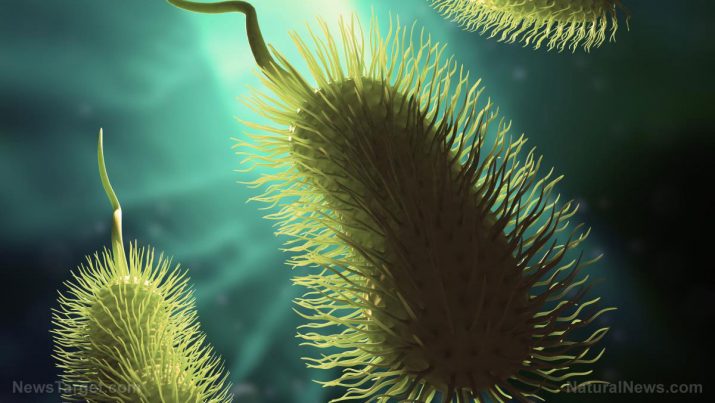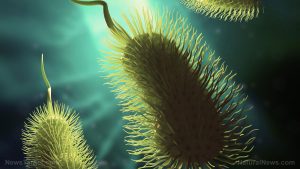
Donovanosis – causes, side effects and treatments at NaturalPedia.com
Saturday, March 10, 2018 by Ralph Flores
http://www.naturalpedia.com/donovanosis-causes-side-effects-and-treatments-at-naturalpedia-com.html

Donovanosis, also known as granuloma inguinale, is an infection caused by the bacteria Klebsiella granulomatis. The infection is located in the genitals, where it forms painless, ulcerative lesions, and can coexist with other sexually-transmitted diseases. However, there are some cases where donovanosis also affects the mouth and the anal region. If the condition is left untreated, it can develop into secondary bacterial infections.
The condition, which is more commonly seen in men, primarily affects the skin and the mucous membranes in the genital region. The ulcers then slowly expand, making them locally destructive. It is usually transmitted through sexual intercourse, primarily through the fecal route or an infected birth canal.
The disease is rarely seen in the U.S., and there are only around 100 cases reported per year. However, K. granulomatis is native to tropical and subtropical areas like southeastern India, Guyana, and New Guinea – where it can infect people who have traveled to areas where the disease is prevalent.
Infections occur in people aged 20 to 40 years.

Known risk factors and symptoms of donovanosis
The leading risk factor in getting donovanosis is unprotected sexual intercourse with multiple partners.
In men, the infection is found in the penis, scrotum, groin, and the thighs; whereas, women are usually infected in the vulva, vagina, and perineum. On occasion, it has also been seen in the anus and buttocks as well as in the face of people with the condition.
The incubation period of K. granulomatis can reach up to 12 weeks. After this period, lumpy, red bumps will appear in the sites of infection. The nodules will slowly progress, becoming a raised, beefy red, moist, smooth, and foul-smelling lesion. After the legion enlarges, it ulcerates which spreads the bacteria to other areas of the skin. This makes the genitals, and the skin around them, lose skin color.
If the bloodstream gets infected by K. granulomatis, this can lead to anemia, wasting, and even death.
Body systems affected by donovanosis
As donovanosis is a sexually-transmitted infection, it primarily affects the genital area.
Food items or nutrients that may prevent or relieve donovanosis
Proper diet can attenuate the complications brought about by donovanosis, as well as other sexually-transmitted diseases. Here are some recommended food items to help with the condition.
- Garlic — It contains allicin – a potent antibacterial and antiviral agent. Garlic also possesses anti-inflammatory properties, which can help soothe the swelling of the affected organs.
- Milk thistle — Silymarin, the active ingredient in milk thistles, is known to address STDs caused by certain parasites and boost the immune system.
- Licorice root — The herb’s healing agent, glycyrrhetinic acid, is present in the roots. This improves the function of the immune system and provides increased resistance in areas of the body that are already infected.
- Lemon balm — It is especially potent against viral infections and helps regulate inflammation.
- Coneflowers — This species of the daisy flower family can be used to boost the hormonal function of the body, as well as improve the immune system.
- Neem tree fruit — Its medicinal properties are known to be effective in treating STDs, and it regulates the immune system.
- Yogurt — Particularly effective for women, yogurt helps stabilize the pH balance in their system, keeping the symptoms to a minimum.
Treatment and management options for donovanosis
Oral antibiotics are widely used by healthcare professionals to treat donovanosis. These include tetracyclines, macrolides, and trimethoprim/sulfamethoxazole (TMP/SMX). The initial response to treatment should begin after a week, but people with severe infections and HIV/AIDS may need prolonged or intensive treatment.
Where to learn more
- Doctors slam the total health lunacy of Obama opening the border to contagious STDs
- Vasectomy ‘parties’ on the rise as couples celebrate future ‘child-free’ lives
- Overwhelming evidence: How vaccines cause ‘hypersensitivity’ of the immune system and lead to extreme allergies, autism, and death
- Documents emerge proving Dr Andrew Wakefield innocent; BMJ and Brian Deer caught misrepresenting the facts
- Proteolytic enzymes: A miracle cure the medical monopoly is keeping from you
Summary
Donovanosis is an infection caused by the bacteria K. granulomatis. The infection is located in the genitals and can coexist with other sexually-transmitted diseases, but there are cases where it also affects the mouth and the anal region. If the condition is left untreated, it can develop secondary bacterial infections.
The condition is which is more commonly seen in men. It is rarely seen in the U.S., as K. granulomatis is native to tropical and subtropical areas. The leading risk factor in getting donovanosis is unprotected sexual intercourse with multiple partners.
Sources include:
Tagged Under: Tags: donovanosis





